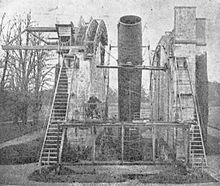The Asteroid
Threat
Widnes
SciBar - 11th Nov 2015
Andy Newsam,
Professor of Astronomy Education and Engagement, Liverpool John Moores
University.
The craters peppering the
Moon are a sign of how asteroids can come into the vicinity of the Earth - the age
of these craters can be estimated from the amount of weathering that has taken
place. There are far fewer known craters on the Earth but not all asteroid strikes
will have left an identifiable crater - some will have landed in an ocean or
vegetation may have obscured some craters on land.
catastrophic
for life on the Earth.
| Craters |
In 2004 there was a ‘near
miss’ when an asteroid of about 900 metres diameter passed between the Earth
& Moon. If it had hit land on Earth it would have caused a crater about
‘the size of Wales’, throwing up a massive dust plume that would spread rapidly
in the higher atmosphere and could block out sunlight and so stop plant
growth. Such an asteroid landing in an ocean would trigger a massive tsunami
that would travel round the Earth. The Near Earth Asteroid
Rendezvous (NEAR) space mission that landed on asteroid Eros in 2000 and the
Rosetta Mission & its Philea probe landing on Comet 67P in 2014 have
greatly increased the scientific understanding of asteroids. Previously,
knowledge was limited largely to observing them from Earth and the evidence
obtained from them hitting the Earth.
Andy described how scientists are seeking how to identify asteroids that pose a threat, how to track them and make them safe.
Detection. Most of the detecting work
has now been done - it is believed that about 90% have been identified.
| Liverpool Telescope, La Palma |
Tracking. Tracking is currently the
main focus of activity. It is being done by a combination of amateur
observation (e.g. the privately run Spaceguard Centre in Mid-Wales) & large
telescopes that are needed to track the smaller & more distant asteroids.
Andy and his colleagues use Liverpool Telescope on the island of La Palma - it
is the world’s largest fully robotic telescope, i.e. it can be operated from
Liverpool. With such telescopes it is possible to pick out an asteroid from
many stars by comparing images of the same area of sky taken some time apart -
in contrast to the stars, an asteroid will have moved. Much of assessing is
done by software but as it can only be relied upon to detect 95% of asteroids, the process isn’t perfect.
From these images, the
course of an asteroid can be predicted for up to 100 years. If that suggests a
danger to the Earth, the asteroid’s track will be kept under review - in time,
a more accurate prediction of an asteroid’s risk can be made, often with a
decision to remove it from the risk list.
As part of his ‘public
engagement’ role, Andy spoke about involving children in identifying asteroids from
two or more time-separated images from the Liverpool Telescope. A 12 year old
spotted a faint trace that the professionals hadn’t noticed!
Making Safe. As yet we have no means of
‘making safe’ n asteroid heading our way. Use a nuclear bomb to blow them up?
Apart from the practicalities of doing it, this could cause the Earth to be
bombarded with broken lumps of the asteroid. Other possibilities include deflecting
the asteroid’s path such as with the gravitational effect of a nearby massive
weight (a ’gravity tractor) or painting one side white. If tracking identified
a threat 20 years off, would there be the time & motivation to find a way
to try to prevent a collision, to practice it & then to use it to make the
Earth safe?
Further Information
Andy is Director of the
National Schools Observatory; ‘an online resource that brings the Universe into the classroom’:- http://www.schoolsobservatory.org.uk/
Video of Andy actively
engaging young people into science. Worth watching; Andy talks about finding
asteroids from 42 minutes:- http://www.iop.org/resources/videos/education/schools-and-colleges-lecture/page_50047.html
Spaceguard Centre,
Mid-Wales:- http://spaceguardcentre.com/
Bob Roach 30th Nov 2015







